- Bernard Preston homepage
- Brain foods
Good brain foods
Today we discuss good brain foods and other essential habits to prevent dementia.
Remember that the brain is a hugely busy organ consuming nearly half of the oxygen we breathe in. That is why a sudden loss of blood-supply to any part of it has such tragic consequences.
Blood oxygen should be above 95 percent but if for any reason it dips below this then all our organs but especially the brain are at risk. This is why the coronavirus is so dangerous as it causes what scientists are calling "silent-hypoxia;" levels even below 50% with no signs of difficulty breathing.
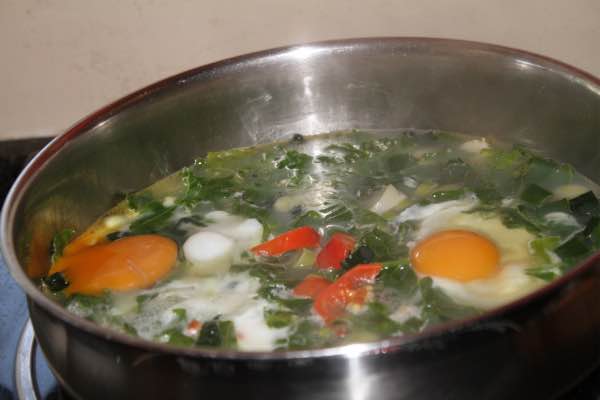 Eggs Hilton with peppers, garlic and kale
Eggs Hilton with peppers, garlic and kaleAnything that raises blood glucose abnormally causes inflammation; especially in those who have diabesogenic T2D where there is insufficient insulin to move that sugar out of the capillaries and into the cells. So there is a tendency for tiny clots to form in the arteries.
Add to that the dramatic inflammation in the capillaries of the lungs caused by the Covid cytokine-storm; the blood oxygen entering the brain drops drastically.
Damage to the brain cells then causes what is generally being termed Long Covid; neurological symptoms that continue for many months after the infection is over.
Favourite good brain foods
- Green leafy vegetables like broccoli, kale and spinach.
- 100% whole grains and new potatoes.
- Pumpkin and butternut; and in fact all the brightly-coloured vegetables like beetroot too.
- Oils rich in omega-3 fatty acids like those from flaxseed and cold water fish.
- Free-range meat and chicken; and eggs.
- Dairy products are a little more controversial but I include them, and especially the probiotic kefir; but only if the overall diet is alkalising.
- Green broad-beans.
Good brain foods and other lifestyle considerations focuses in large measure on keeping that blood glucose under control; and an anti-inflammatory larder to protect our capillaries.
Daily exercise particularly after a starchy meal means that the glucose produced from carbohydrate we have consumed will be turned to glycogen instead of raising blood sugar.
GI boundaries
- Low GI: 1 to 55
- Medium GI: 56 to 69
- High: 70 +
Traditionally glycemic index (GI) has been used to determine how an ingested carbohydrate will affect blood glucose; it's based on the same amount of food but of course we often eat vastly different masses of each. Consider for example these standard servings.
- Potato 150g
- Pasta 120g
- Rice 120g
- Butternut 75g
Glycemic load
Glycemic load (GL) is the GI multiplied by the amount of carbohydrate in a typical serving. It is really a more meaningful and useful tool.
- Low GL: 1 to 10
- Medium GL: 11 to 19
- High GL: 20 +
So a single spoonful of boiled white rice, having a very high GI of 86, would have a lesser effect on blood glucose and subsequent vascular inflammation than three measures of pasta with a much lower glycemic index of 49.
Food
- White rice (120g)
- Instant oats (250g)
- Rolled oats
- Potato boiled (150g}
- Pasta (120g)
- Bread, commercial, W or B (40g)
- Bread, wholemeal (40g)
- Bread, 100% wholemeal (40g)
- Legumes (150g)
- Pumpkin (75g)
- Milk (250ml)
- Stoneground grits (65g)
Carb
- 32g
- 26
- 24
- 20
- 31
- 19
- 13
- 14
- 22
- 8
- 12
- 33
GI
- 86
- 79
- 55
- 78
- 49
- 75
- 54
- 45
- 31
- 64
- 32
- 5[6]
GL
- 28
- 21
- 14
- 16
- 15
- 14
- 7
- 5
- 7
- 4
- 4[1]
- 2
The pumpkin family interestingly is used in many traditional communities to treat diabetes; but it has a medium-high GI. How can that be? The answer is that normally a helping size is only 75g giving it a very low glycemic load of 4.
Looking at GI alone one would think pumpkin and butternut are wholly undesirable foods.
So for good brain food one would choose carbohydrates in the lower half of this table; and avoid those in the upper part except when having a very small serving. Two or three spoonfuls of oats are desirable for its other beneficial properties[5]; steel-cut is best.
Sugar and honey
Traditionally simple carbohydrates like sugar and honey were assumed to be digested and absorbed more rapidly with a consequent significant rise in blood glucose.
And starches consisting of chains of thousands of glucose molecules were assumed to be assimilated more slowly; diabetics were encouraged to eat them.
Then finally the science arrived. The fact that boiled rice, potato from cold-storage and instant oats have a far higher glycemic index than either sugar or honey confirmed Mencken's law; and certainly put a cat among the pigeons.
"For every complex problem there is an answer that is clear and simple; and wrong."
- HL Mencken
The evidence is now unequivocal. Refined grains like white rice, commercial bread and boxed oats are the great enemies of the brain; as are potatoes from cold storage, sweetened beverages and most cereals.
On the other hand unrefined grains, sourdough bread made from 100% flour and legumes are certainly good brain foods.
Kefir
There is a huge amount of research now clearly proving that the wellness of the microbiome in the intestine is strongly associated with a low incidence of the neurodegenerative conditions like Alzheimer's disease. Kefir ranks very highly on my list of good brain foods.
Researchers have found that those with a happy microbiome incidentally are far less likely to get long Covid.
Broad beans
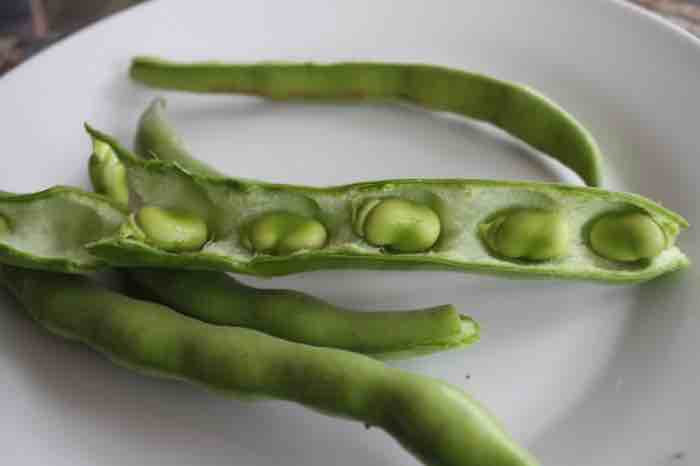 There is even more L-Dopa in the young broad bean pods.
There is even more L-Dopa in the young broad bean pods.Green broad beans are also known as favas; they are almost impossible to buy so you have to grow them yourself. Young and freshly-harvested they are simply delicious; include the pods. Old or dried they are awful.
Broad beans are a very important brain food except when they have been skinned, a common practice. Removing the fibre gives them a high glycemic index; they would then promote inflammation of the capillaries, a greater likelihood of
clot formation and stroke.
Broad beans are the only common natural source of levodopa, the precursor of the feel-good hormone synthesised in a nucleus in the brain called the Substantia Nigra; in more recent times it is commonly being damaged by chemicals in our food and from our environment causing Parkinson's disease.
The bugs known as the normal flora in the happy colon also produce some dopamine.
Parkinson's disease and glaucoma
Parkinson's disease is the fastest growing neurodegenerative illness in the world today; the prevalence has doubled in the last 25 years. It was a rare condition for most of human history until more recent times.
In the context of good brain foods, broad-beans are the only significant source of this phytonutrient that is strongly associated with a low incidence of Parkinson's disease and macular degeneration; it is the precursor of dopamine.
The optic nerve is generally considered part of the brain.
Eggs Parkinson's disease is one of our favourite breakfasts; onions, broad-beans and peppers. Add tomatoes, turmeric and green leafy vegetables for a very tasty and wholesome meal. Enjoy it on low GI toast.
The dopamine in broad beans would certainly be beneficial for those suffering from the depression and anxiety associated with glaucoma; and help normalise the pressure in the eye.
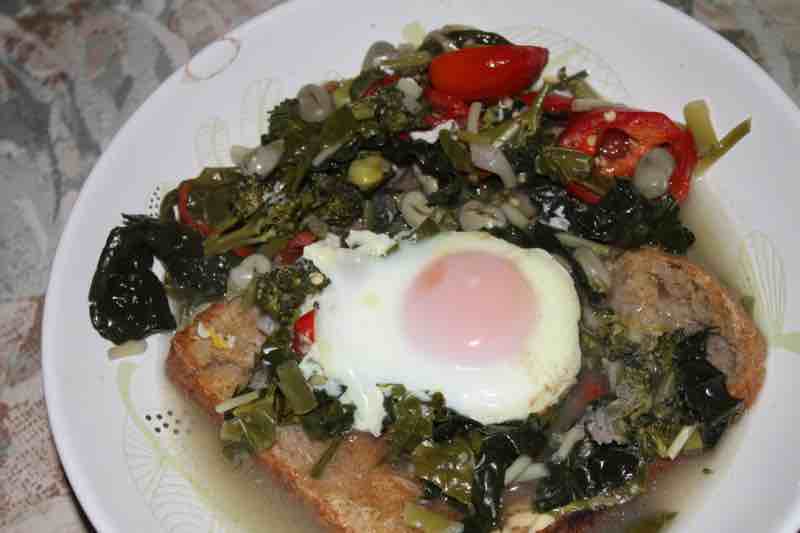
Can you pick out the broad-beans looking rather like very fat, grey ticks?
Free-range eggs incidentally have three times the omega 3, so that would make this wonderful breakfast doubly one of the good brain foods.
One other benefit of the dark leafy greens is the lutein they contain; essential for preventing adult-onset blindness[3].
100% wholemeal sourdough bread
There's a big fat lie in the world of flours where millers and bakers are legally allowed to call their products "wholemeal" even though up to 40% of the bran and germ have been sifted out and sold off for hog food; that is where much of the protein, vitamins and minerals are to be found.
Look for the 100% wholemeal label which means that there has been no sifting into the three streams of bran, germ and endosperm; all the goodies are there.
I include 100% wholemeal sourdough bread in our list of good brain foods, though I have not been able to come up with exact figures. It has a touch more starch, a far greater amount of healthy fat and extra protein; and the fibre too. It's a thumb suck but I would give it a GI of about 50 and a glycemic load of around 4 or 5. Those are all low.
There is a huge amount of research showing that 100% wholemeal is friendly towards blood vessels. The naturally occurring vitamin E alone makes this so; it is an anti-coagulant that is removed along with the fat in the refining of all other flour.
Bake it as a sourdough bread; the naturally occurring lactic acid that is formed in the fermentation promotes a gelatinisation between the gluten and the starch further reducing the bioavailability of the carbohydrate[2].
In short 100% wholemeal bread is very friendly towards the brain but the commercial loaf, cookies and bagels certainly are not. Read more about baking your own using sourdough. It takes me just five minutes every morning.
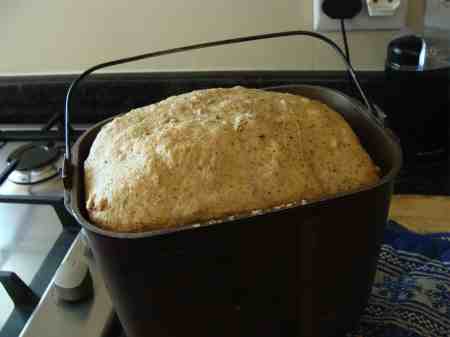
Nuts and seeds
Magnesium is involved in literally hundreds of biochemical processes in the body; and especially the brain. On the typical industrial diet being eaten these days most of us are getting around half of the recommended dietary allowance. Is it any wonder that we are such a sickly people?
Magnesium from nuts and seeds is how to go about making sure you are getting enough of this extremely important mineral; green-leafy vegetables and legumes too.
Magnesium from corn and beans when in season also makes a huge contribution to your general wellness.
Magnesium from spinach is the richest sources of the mineral; dark-green leafy vegetables in general are excellent brain food.
The vitamin E in nuts and seeds is essential to delay the onset of dementia and frailty.
Citrus
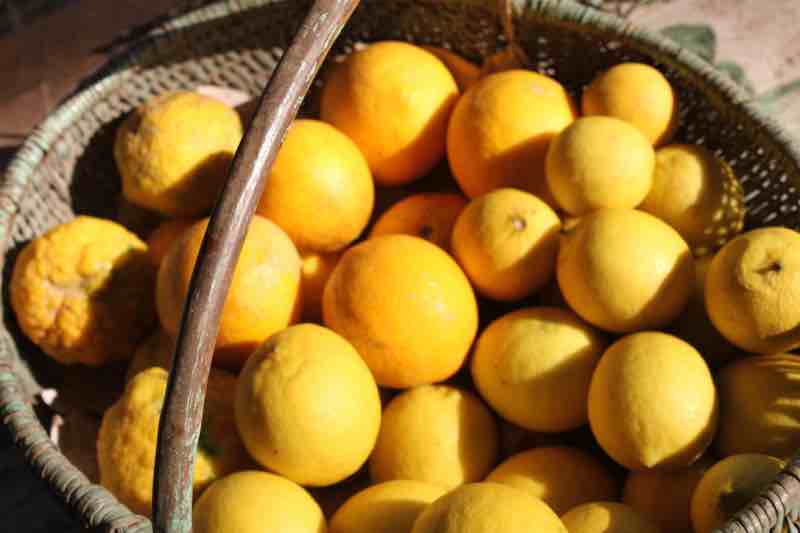
Citrus contains the most powerful anti-senility phytonutrient known. It's called beta-cryptoxanthin; if for no other reason we should all be enjoying oranges and lemons daily. They are seriously good brain food.
Turmeric and ginger
There is strong research that curcumin, one of the active ingredients in both turmeric and ginger makes us more sensitive to the effect of insulin on our tissues; and protects the beta-cells in the pancreas[7].
Try and use both turmeric and ginger regularly in your cooking.
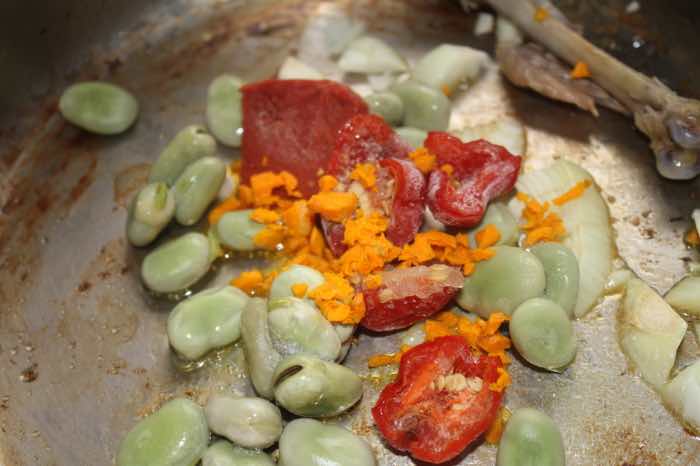 Fresh turmeric, broad beans and peppers.
Fresh turmeric, broad beans and peppers.Lifestyle
When it comes to mental wellness good brain foods are not enough; there are other lifestyle factors that are equally important. Top of the pops is relaxing sleep and that will mean cutting back on refined carbohydrates and alcohol in the evening.
Few activities will help you sleep better than some form of daily exercise; after supper surprisingly is more effective. Whether it's walking, swimming or cycling makes little difference. Your brain needs attention seven days a week. Could you stroll to church, school or the shops? Will you step it out at lunchtime, apple in hand?
It is interesting that in all five of the Blue Zone countries of the world where ten times as many folk live to vigorous and strong old age they are religious; but they belong to different faiths. Unwinding, meditating or being still before God it would seem are important parts of nourishing your brain. A forest bathe without your cellphone might serve a similar purpose. It's all about mental relaxation.
One could add many different activities with the same theme tune; perhaps play your guitar, paint a picture or plant some broad beans in the garden. Opening a beehive and watching the most amazingly organised society at work does a power of good for my own brain.
When did you last go on a hike? It is certainly good for your brain.

Covid and the brain
Covid is often thought of as a respiratory disease, which it is. However this is because the lungs are so richly endowed with blood-vessels for gaseous exchange with the atmosphere.
Covid wreaks its havoc via an inflammatory response in blood vessels; and that means the whole body. The brain too is particularly vulnerable to low levels of oxygen.
In addition because the virus raises the clotting factors in the blood, temporary ischemic attacks and strokes occur in nearly one-fifth of those suffering from an infection.
Also the virus has the ability to pass through the blood-brain barrier that protects the white matter causing further inflammation. Long Covid is no mystery; the mitochondria that produce the energy the cells need are harmed, so victims feel constantly tired.
The result is that enormous fatigue is strongly associated with the viral infection of the brain.
What's to be done?
First let's look at the bad brain foods. The consistent evidence is that it is those who are insulin-resistant who are highly vulnerable; that means raised blood glucose. Refined carbs are public enemy number one when it comes to Long Covid. They are rapidly digested in the small intestine flooding the portal system with sugars.
So it comes as no surprise that more than half of those dying from Covid are obese or type-two diabetic; in fact, if you talk to them they all had issues with inflammation long before the virus arrived. The cytokine storm released by the bug, attacking our blood vessels starting in the lungs is simply the proverbial straw that breaks the camel's back.
Keeping sugar, cake flour and white rice strictly under control is the first objective; in fact if we all did that anyway, our wellness would spring forwards in leaps and bounds.
Understanding the issues around net carbs is an important step for everyone; the important fibre in whole foods slows and blocks the rapid digestion of starches.
Good brain foods
- A homemade probiotic like kefir is first up on my list of good foods; the colon is now being called the second brain. A broad spectrum of the microbiome is our best protection against dementia and a Covid storm.
- Taking a short walk after a starchy meal is a sure way to keep our blood glucose down and prevent that cytokine storm. We should all do this anyway if we want to enjoy long and pain-free lives.
- Enjoying many coloured good brain foods each day is important; they containing the anti-inflammatory phytochemicals[4], not only in these pandemic times but always to reduce the anger in our tissues.
Good brain foods
So it is all about good brain foods because prevention always was and still is better than a cure; by the time you have Alzheimer's disease it is too late.
- Dietary carbohydrates: role of quality and quantity in chronic disease
- On the Effect of Lactic Acid on Blood Glucose and Insulin Responses to Cereal Products
- Lutein macular degeneration.
- Top seven functional foods
- Quaker oats recipes
- Glycemic Index of stoneground grits is only 5 according to Canadian Insulin; suspiciously low.
- Curcumin and Type-2 Diabetes Mellitus: Prevention and Treatment
When browsing use right click and Open Link in New Tab, or you may get a bad gateway signal.
Newsletter
Our newsletter is entitled "create a cyan zone" at your home, preserving both yourself and Mother Earth for future generations; and the family too, of course. We promise not to spam you with daily emails promoting various products. You may get an occasional nudge to buy one of my books.
Here are the back issues.
- Lifestyle and ideal body weight
- What are ultra-processed foods?
- Investing in long-term health
- Diseases from plastic exposure
- Intensive lifestyle management for obesity has limited value
- A world largely devoid of Parkinson's Disease
- The impact of friendly bacteria in the tum on the prevention of cancer
- There's a hole in the bucket
- Everyone is talking about weight loss drugs
- Pull the sweet tooth
- If you suffer from heartburn plant a susu
- Refined maize meal and stunting
- Should agriculture and industry get priority for water and electricity?
- Nature is calling
- Mill your own flour
- Bake your own sourdough bread
- Microplastics from our water
- Alternative types of water storage
- Wear your clothes out
- Comfort foods
- Create a bee-friendly environment
- Go to bed slightly hungry
- Keep bees
- Blue zone folk are religious
- Reduce plastic waste
- Family is important
- What can go in compost?
- Grow broad beans for longevity
- Harvest and store sunshine
- Blue zone exercise
- Harvest and store your rainwater
- Create a cyan zone at your home
Did you find this page interesting? How about forwarding it to a friendly book or food junkie? Better still, a social media tick would help.
- Bernard Preston homepage
- Brain foods
Address:
56 Groenekloof Rd,
Hilton, KZN
South Africa
Website:
https://www.bernard-preston.com